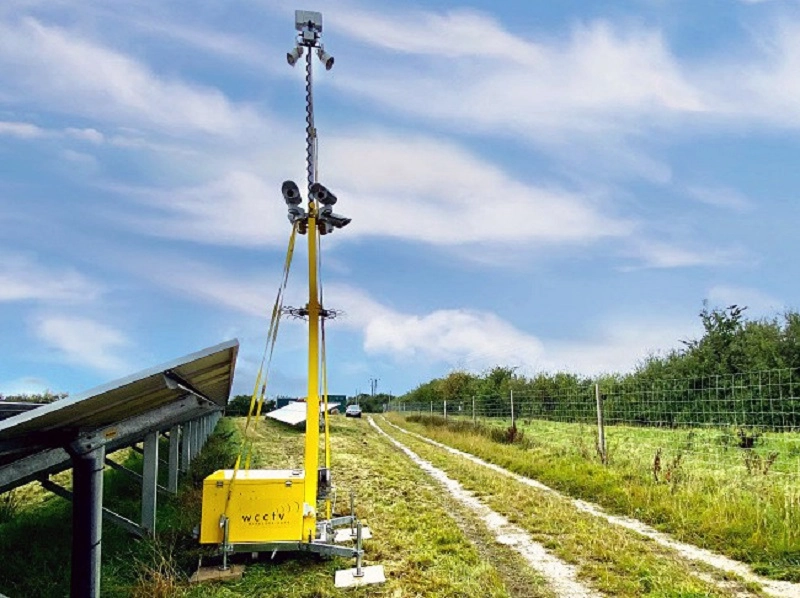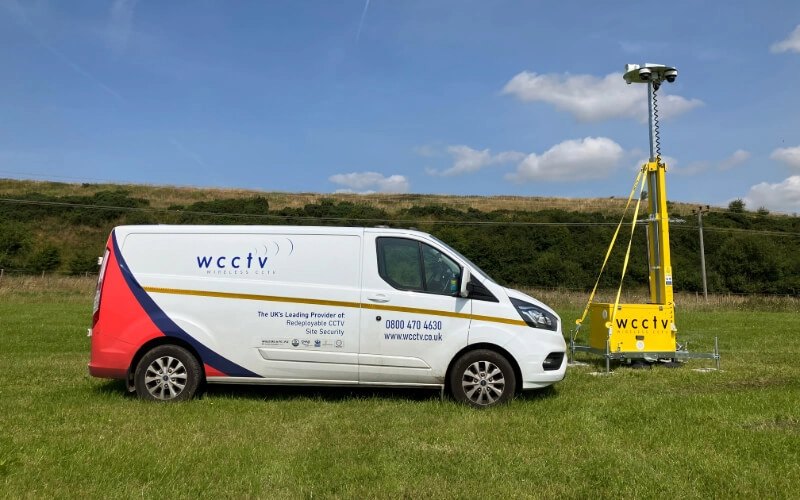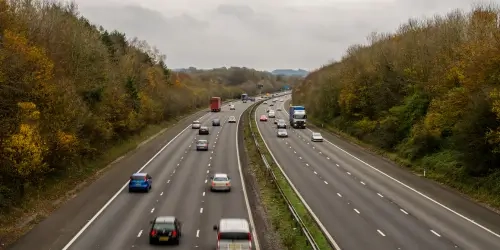High-speed road projects are among the UK's biggest infrastructure investments, with contracts often worth millions of pounds. In these highly competitive tenders, security specifications can be the deciding factor between winning and losing a contract.
When project teams rely on generic security requirements that don't reflect the real challenges of roadworks, it often results in missed opportunities and weaker bids.
So, what does a strong tender need to stand out?
In this guide, we'll explore why security specifications matter in road project tenders and share 7 practical tips to help you build a winning bid.
Why Security Specifications Matter In Road Project Tenders
Security specifications form the key part of the contract documents for road project tenders, outlining clear security requirements from the get-go. This upfront clarity eliminates uncertainty and prevents disputes that can derail projects later. More importantly, it guarantees that projects meet all compliance standards and legal obligations.
These specifications also play a role in protecting community interests, safeguarding sensitive information and securing valuable equipment and materials on work sites. On top of that, they give contractors clear guidance on managing site security, controlling access and responding to incidents, all of which keeps projects running safely and smoothly.
Here's a quick overview of these security measures' benefits:
-
Legal protection: Binding contract terms that reduce project risks and disputes.
-
Regulatory compliance: Adherence to Construction (Design and Management) (CDM) Regulations 2015, Health and Safety Executive (HSE) Regulations, environmental laws and relevant UK road works rules.
-
Risk reduction: Clear procedures for managing site security and responding to incidents.
-
Cost certainty: Accurate pricing and planning based on the scope of work.
-
Performance standards: Measurable milestones for service delivery.
Security measures commonly specified include:
-
Physical site security controls (fencing, physical barriers, perimeter protection).
-
Surveillance systems (CCTV, alarms, armed response).
-
Access control procedures, site personnel management and authorised visitor entry controls.
-
Confidentiality and data security related to project information.
-
Emergency procedures and reporting requirements.
Getting your security responsibilities and specifications right is vital to proving you can meet safety and compliance obligations. For many buyers, these details become the deciding factor, as they demonstrate strong risk assessment and reduction measures that directly support project delivery goals.
7 Tips for Writing Winning Security Specifications in the UK
After reviewing thousands of successful and rejected tenders, certain patterns emerge. Here are 7 tips for writing winning security specs for UK road projects:
Address site-specific challenges
Generic security specs and site security measures won't cut it. Buyers can quickly tell the difference between inexperienced contractors and those who understand the realities on the ground.
To stand out in tenders, you need to show a clear understanding of the project environment and site layout and how your security measures are tailored to those site-specific challenges.
Consider factors such as:
-
Site geographics: Elevated sections, bridges, embankments, access points, tunnels, viaducts, verges and drainage features.
-
Duration and phases: Provide different security requirements during excavation, construction and completion.
-
Local crime patterns: Review historical crime data in the project area (theft, vandalism, anti-social behaviour, fly-tipping, etc.)
-
Weather conditions: Explain how seasonal conditions affect security coverage and project milestones.
-
Traffic management: Include how lane closures and diversion routes will be handled.
For example, specify how your security approach adapts to different construction sites and phases. A motorway widening project needs different protection during initial groundworks compared to the final surfacing phases.
Our Traffic Management Towers can be repositioned to adapt to changing site layouts. Equipped with a near-360° field of view and in-built AI-video analytics, they detect incidents, monitor lane closures and respond quickly to road issues in real-time.
Highlighting these capabilities in your tender proposal shows a clear understanding of the site and its challenges, helping your bid stand out from more generic submissions.
Top tip
Conduct a thorough site visit before compiling your risk assessment. Use expert teams who understand both security requirements and construction logistics. Take photos of specific areas, access points and potential blind spots and reference those specific site features in your bid to demonstrate genuine site knowledge.
Specify advanced mobile surveillance technologies
Traditional, fixed CCTV systems rarely suit road projects due to changing site layouts and the temporary nature of construction site zones. Standing out in competitive procurements requires site safety solutions that cater to these challenges.
Include technical specs for:
-
Rapid deployment capabilities: Systems that install within 20 minutes (standard setups) without permanent infrastructure.
-
Autonomous operation: Solar-powered units with up to 20 weeks of operation.
-
Mobile connectivity: Secure 4G/5G transmission for remote monitoring.
-
Weather resilience: Purpose-built equipment for harsh outdoor environments.
-
Remote diagnostics: Automatic system health checks to prevent on-site maintenance visits.
-
Coverage: High-definition (HD) PTZ (Pan-Tilt-Zoom) cameras with near-360° coverage.
-
Camera features: Night vision and thermal imaging capabilities during low-light conditions.
-
AI-video analytics: Smart software that distinguishes genuine threats from false alarms.
-
Smart integrations: Supports integration with ANPR, PID systems and Body Cameras.
Our Temporary CCTV solutions are purpose-built for road projects. Bright yellow Traffic Management Towers stand up to 6 metres tall and provide wide-area security coverage.
Each unit is fully autonomous (powered by solar and fuel cell batteries) and equipped with AI-video analytics. Basic setups can be deployed within 20 minutes, and all footage and alerts are transmitted securely over 4G/5G networks to professional monitoring centres in real-time.
By highlighting these smart detection systems in your tender bid, you demonstrate that traffic management, security threats and incident response can all be managed from a single unit. This unified approach shows buyers you understand operational efficiency while delivering measurable [ROI], giving you a clear advantage over competing bidders.
Top tip
Request specific technical datasheets from suppliers and include key specifications in your tender. Mention exact camera resolution (4K), transmission methods (4G/5G) and power autonomy periods (up to 20 weeks).

Include professional monitoring services
Record-only CCTV systems provide evidence after security breaches occur and, therefore, offer no real-time protection for roadwork projects.
Winning specifications include 24/7 professional monitoring that prevents security incidents before they impact project timelines.
-
NSI Gold Accredited centres: The highest industry standard for alarm monitoring.
-
Real-time threat assessment: Trained security personnel distinguish real threats from false alarms, even during out-of-office hours.
-
Immediate response: Live voice-down audio warnings, dispatch of mobile keyholding team and/or contact of emergency service if and when needed.
-
Police contact: Direct communication with local authorities for verified threats.
-
Incident reporting: Time-stamped documentation for compliance, insurance and legal purposes.
-
Remote access: Stellifii's cloud-based platform creates a single system for security, safety, compliance, project management and condition monitoring from any device, anywhere.
Our professional monitoring services transform passive surveillance into proactive security management.
When operators detect unusual site activity, they can challenge intruders instantly through integrated speaker systems, often preventing incidents entirely. This proactiveness shows your commitment to preventing crime rather than simply documenting it.
Top tip
Name the specific monitoring centre/security provider in your tender and include their accreditation details. Mention response timeframes (under 60 seconds for threat assessment) and escalation procedures. Include a sample incident report format to show the quality of documentation clients can expect throughout the project.
Demonstrate industry compliance and regulations
When it comes to road projects, compliance is non-negotiable. Your security specification should clearly show awareness of key UK safety, environmental and security requirements, including, but not limited to:
-
Road Safety Risk Assessment (GG 104): Use of the RRRAP tool to evaluate hazards and prioritise safety measures.
-
Highways England standards: CD 377 requirements for roadside equipment.
-
Site safety responsibilities: Appointment of a Traffic Safety Officer (TSO) to oversee inspections, signage, reporting and training.
-
Road Restraint Systems (RRS): Compliance with CD 377 in the Design Manual for Roads and Bridges (DMRB) for barriers, crash cushions, terminals and guardrails.
-
CDM Regulations 2015: Defined site security responsibilities.
-
Working at Height Regulations 2005: Safe procedures for tower installation and maintenance, in line with HSE regulations.
-
Environmental protection standards (ESG): Measures to minimise ground disturbance, monitor site conditions and reduce carbon footprint.
-
Data protection laws: GDPR compliance for video surveillance and storage.
Demonstrating regulatory insight proves you understand the complex legal requirements that govern major infrastructure projects in the UK. This positions your bid more strongly against generic submissions, signalling credibility to buyers.
Top tip
Create a compliance checklist and reference specific Acts and/or regulation numbers in your tender. For example, use the phrase "compliance with CD 377 Section 4.2 for roadside equipment" rather than "meets Highways England standards."
Include environmental monitoring
Modern road projects focus increasingly on environmental impact that aligns with the UK's Net Zero 2050 strategy. Mention environmental monitoring within your security specs to address any buyer concerns.
-
Dust levels: Real-time air quality and CO₂ emission measurement and reporting.
-
Noise monitoring: Compliance with "statutory nuisance" guidelines set by the Environmental Protection Act 1990.
-
Weather conditions: Wind, temperature and humidity for safety planning.
-
Vibration measurements: Impact assessment for nearby structures.
-
Traffic flow analysis: Data collection for post-project evaluation.
All of our CCTV Towers support environmental IoT-based sensors, providing Section 61-compliant monitoring alongside security coverage. This dual functionality demonstrates forward-thinking integration of mobile surveillance technologies that can help strengthen bids.
Top tip
Include sample environmental reports in your bid that show real data from previous projects. Specify monitoring intervals (15-minute readings), alert thresholds (dust levels above 200 μg/m³) and automated reporting capabilities. This demonstrates both technical capability and transparency that clients value.
Compare costs
Site security represents a substantial portion of total project costs. Specifications that showcase cost-effectiveness while providing reliable surveillance score well with procurement teams.
Compare your approach against alternatives:
-
Mobile surveillance vs security guards: Reduce costs by up to 88% with 24/7 consistent coverage.
-
Hired surveillance vs outright purchases: Flexible CCTV Tower rentals when surveillance is needed.
-
Autonomous systems vs mains power units: Lower running costs and maintenance visits.
-
Integrated systems vs individual systems: Single platform to prevent vendor sprawl.
-
Redeployable equipment vs static installations: Multiple asset usage within the rental period across project phases.
Include specific cost comparisons. For example, traditional security personnel cost between £25,000 and £35,000 per person annually, while our fully-managed service provides superior coverage at a fraction of the price. This shows you've done "the numbers", giving buyers confidence in both the value and financial credibility of your proposal.
Top tip
Include a detailed cost comparison table showing annual costs per security method. Include all hidden costs like fuel, maintenance and staff overheads for traditional guards.
Also mention the headaches that accompany managing onsite security teams. Present the monthly rental fees for mobile CCTV alongside projected savings over the full project duration to make the value proposition crystal clear.
Specify scalable security solutions
Road projects constantly evolve throughout construction phases. Security specs must highlight adaptability to changing landscapes without impacting budgets.
Mention flexible, scalability features:
-
Modular deployment: Add, relocate or reposition units as work zones shift.
-
Equipment upgrading: Enhance security with add-on features (like ANPR and Time Lapse Video) during extended project phases.
-
Seasonal adjustments: Adapt to changing lighting and weather conditions, including those in remote locations.
-
Integration function: Connect with existing client security systems.
-
Technology updates: Software improvements during the contract period.
Our Stellifii platform simplifies how teams manage security, safety, compliance and site conditions.
Instead of switching between multiple tools or managing multiple suppliers to collect data, Stellifii brings all of this together in one place. It delivers faster decisions, better visibility and more control for you and buyers.
Top tip
Include a project timeline diagram that illustrates how security coverage adapts across different phases. For example, "Week 1-8: 3 mobile units covering excavation area" and "Week 9-16: Relocate 2 units to bridge construction zone." This visual approach shows your planning capability and reassures clients that there will be no security gaps during transitions.

Take Your Road Project Tenders to New Heights
Strong road project security specifications are what separate winning tenders from generic submissions. By addressing site-specific challenges and demonstrating technical knowledge, regulatory compliance and cost-effectiveness, your proposal becomes a competitive advantage rather than just a compliance exercise.
Our Traffic Management Towers and fully-managed monitoring service provide the foundation for stronger, smart security specs. With 6 regional hubs and a proven track record in major infrastructure projects, we help contractors secure more tenders at better margins.




